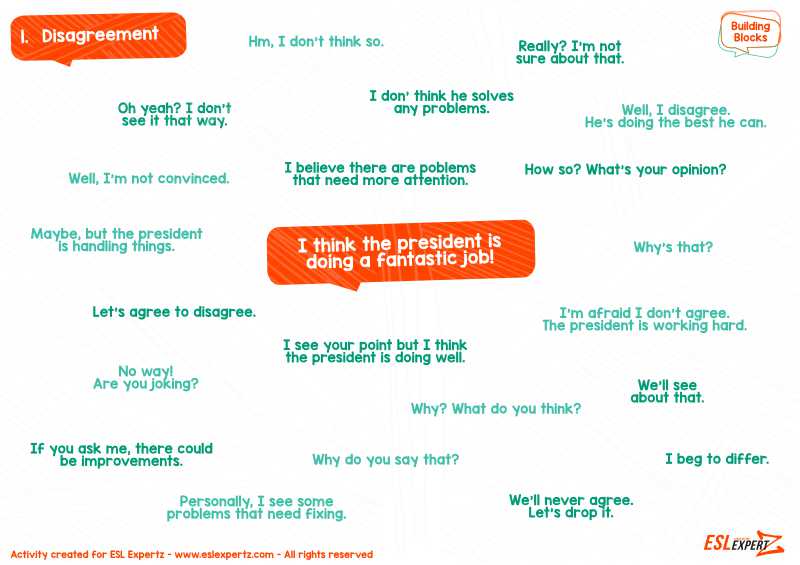
ESL Agree and Disagree Activity – Have an Argument in English
Have a good time with your A2 and B1 students while they learn how to argue with this ESL agree disagree activity.
Practice makes perfect, so let your beginners practice and practice and practice some more. In our English Dialogue Building Blocks activities, we dissect some basic dialogues in useful contexts to help your students feel more comfortable with the (real life) basics. In pairs, students will use the fragments of larger dialogues to create their own, giving them the chance to see and repeat useful phrases and keywords in order to integrate them into their speech. This particular ESL agree disagree activity is for having an argument in English. Your A2 ESL students will learn great phrases to agree and disagree, while your B1 students can practice their argumentative skills! There are three pages: disagree, agree, role-play scenarios. The agree page also includes a bit of “concession” language, in order to make the discussion a little bit more interesting.
Here’s how it works:
Building Blocks: This activity is designed for your A2/B1 learners. You will see a framed starting sentence in the middle and scrambled sentences around it. Your learners must try to reconstruct a dialogue starting from the framed sentences. There are, of course, multiple possibilities for dialogues. You can have your students work in pairs. To liven up the class, you can also give additional instructions, such as creating the longest or most original dialogue. PLEASE NOTE that it is generally impossible to use all the sentences in a single dialogue. Students can use the checkboxes if working online to keep track of which fragments they’ve already used. You could gamify the activity even further by comparing how many checkboxes each pair was able to use, keeping in mind a fragment that has been marked cannot be used twice (to keep it simple and to let your students repeat and practice, ignore the checkboxes).
For example:
A: I think the president is doing a fantastic job!
B: Oh yeah? I don’t see it that way.
A: How so? What’s your opinion?
B: If you ask me, there could be improvements.
A: I see your point but I think the president is doing well.
B: Let’s agree to disagree.
Role-Play Scenarios: You have three different role-play scenarios. Here, too, you can ask your learners to work in pairs to create dialogues based on the chosen situation. You can then ask your students to perform their dialogues in front of the class. They can agree in advance on the development of the dialogue, but they can also improvise. Another variation is to have them individually imagine a short written dialogue as homework in response to a situation.
Reviews
It takes a team of 13 to create and produce this material. In order for that to continue, please think about purchasing your own subscription to ESL Expertz and encourage your colleagues to do the same. We appreciate your confidence and support!
There are no reviews yet.